
Wine Culture and Information since 2002 - Volume 22
 Wine Culture and Information since 2002 - Volume 22 |
|
Issue 163, June 2017 |
Contents |
|
|
Frozen Vineyards |
|
The joyous moment when a bottle of wine is uncorked and it is poured into glasses, is the fruit not only of grapes but also of countless factors and events. Fruit of hard work beginning in the vineyard and ending in the bottle. Vineyard, the place where everything originates from, is cause of many worries for every vintner. It can in fact be said most of the worries takes their origin from the vineyard. It is no secret, in fact, sound and quality grapes make - with no tricks or magic - wines of remarkable quality; with bad quality grapes can be made - in the best case - mediocre wines. For this reason, understandable and fundamental, every vintner is forced to always be attentive and aware of what it is happening in the vineyard, knowing very well that, in case of need, he or she must quickly do something. Neglecting a vineyard, or delaying a necessary treatment, means compromising the quality of the wine to come. It should however be said a vintner does not have the power of omnipotence. There are in fact events and conditions for which can be found a remedy, whereas in other cases all the vintner can do is to stand helplessly while watching what it is happening in the vineyard and suffering the consequences, even serious ones. It is about events, more or less exceptional, caused by the will of Mother Nature that, like everyone knows, can be both generous and evil. It can be in fact easily imagined, at the end of 1800s, the desolation of vintners who were helplessly watching their vineyards dying without even knowing anything about the cause. As it is commonly known, many years will pass before understanding the responsible of such a devastation was a tiny aphid to which was given - among the many things - the significant name of Phylloxera Vastatrix and that will change viticulture in Europe forever. Phylloxera, just like every living species, certainly is part of Nature, despite its effects are not evidently positive for Vitis Vinifera, that is the vine giving grapes for making wine. It should be said the main responsible for that devastation was not Nature but man who introduced - although unintentionally - phylloxera to Europe. Man was the responsible for that environmental alteration Nature did not create and the result was catastrophic as to completely change the cultivation of vine in Europe. Man was however capable to find a remedy to that terrible event and, there is no doubt about this, the risk was very high: “all is well that ends well”. Vintners are however called to face the adversities of vine - as this is an unrepeatable and unique value - by trying to find a remedy as much as possible. This is what virtually happens from the moment of pruning to harvesting, while relying on Mother Nature's benevolence and the possibility to find a remedy. It is not always possible to find a remedy for the more or less extraordinary events happening in the course of the season and consequences can be even catastrophic and may compromise harvesting and, therefore, profits. This is what happened last April when in Italy exceptional meteorological conditions caused a serious frost with grave consequences for Italian agriculture. Damages have been reported in many Italian regions, not only vineyards, but also orchards and plantings of vegetables. Moreover, in some areas have also been reported damages caused by strong wind and hail. A preliminary estimate of damages determined a loss - in certain cases - as high as 80% for the harvesting to come. The frost, with its drastic lowering in temperature below zero, has literally burnt the young buds of plants right in the moment of blossoming. The consequence is obvious: when the flower dies, the plant will not give any fruit. According to the figures reported by Coldiretti (Italian Confederation of Agriculturists) damages caused by the frost can be more than one hundred million euros. As for damages reported in Italian vineyards, there are many producers who have suffered of a remarkable loss and they are supposed to suffer a loss of even 80% less than past years. The frost hit Northern and Central Italy, down to Campania, including Sardinia. The production of grapes in these regions will unavoidably be affected by the effect of last April's frost and in many areas wine production will be drastically limited. This means wines of vintage 2017 will be produced with grapes harvested from vines saved, or partially saved, from the frost. According to what producers said the days following the frost, many of them have suffered serious loss from this catastrophic meteorological event. Nature gives, Nature takes away. Generous when it gives, severe when takes away. This is something agriculturists know very well - and, of course, vintners too - who are facing every year such conditions, in the edge of hoping for the best harvest and the fear of seeing the hard work of an entire season ruined in moments. It is however impossible not to note that in recent years we are seeing drastic climate changes and they have direct consequences on everyone's life, not just in agriculture. Coldiretti's esteems report climate changes happening in Italy in the past years have caused damages for about fourteen billions euros. The proof we should certainly consider the consequences of our actions, most of the times selfish and not so respectful for the future. I would like to express - for the little it gives - my understanding and comprehension for vintners and agriculturists of Italy, wishing them all they will however be capable of giving us a great vintage. For what they can, with what they have, for the best they can. As usual. Antonello Biancalana
|
||||
Contrasts of Falanghina and Pinot GrisOne of the most famous white grapes of Campania compared to one of the international glories which found in Italy one of its places of expression |
|
The huge richness of grapes found in the Italian territory - the National Directory of Grape Varieties lists more than five-hundred - has no equal in any other wine making country in the world. To the rich heritage of indigenous varieties - so rich each region has their own - have been added, in more or less recent times, also the so called international grapes. Most of them is, as everyone knows, of French origin, grapes that today are widely spread in every country of the world in which is being produced wine. Thanks to the remarkable presence in the Italian territory, these varieties - today cultivated everywhere in Italy - express in every region unique and identifying qualities, however expressing their typical character. A condition which evidently occurs for every grape and for every territory, however, as for international varieties this is something becoming even more interesting because of their spreading and therefore the diversity in expression. Pinot Gris is one of the many allochthonous grapes introduced in Italy and that, in some regions, has been capable of expressing a particular and identifying character as to become a reference model for other wine making countries. Pinot Gris will be compared to one of the glories of Campania, Falanghina, one of the most prestigious white berried grape of this region. Two clearly different varieties, of remarkable personality, which will evidently show their respective differences while expressing their own qualities. We will see, in fact, Falanghina and Pinot Gris express very different sensorial characteristics to the senses of the taster in many regards. They are therefore two varieties well suited for our study based on contrasts. Grapes of remarkable wine making versatility, Falanghina and Pinot Gris are also well suited for the production of wine by using many techniques while making very interesting styles.
|
|
Falanghina is one of the most famous and representative white berried grapes of Campania. A variety particularly common in the territory of Benevento - in particular in the Sannio Denominazione d'Origina Controllata area - Falanghina is widely common in other areas of the region as well. Among the many is mentioned Campi Flegrei area in province of Neaples. On this regard we should notice there are two varieties sharing this name: Falanghina Beneventana and Falanghina Flegrea, different grapes according to a genetic point of view. These two varieties however make wines having pretty similar organoleptic characteristics, although they are distinct varieties having no genetic connection. This caused, in past times, a certain confusion between the two varieties, something cleared only after proper genetic research. The two varieties also differ for the shape and size of bunches, as well as for the areas of cultivation. The origin of both varieties is uncertain. As for Falanghina Beneventana, it is believed to be originated from Bonea, a village in province of Bevenento, and its presence is also found in some areas in Avellino. Falanghina Flegrea is one of the most ancient varieties of Campania and it is believed it was introduced in the territory of Campi Flegrei by ancient Greek colonizers. The name Falanghina seems to come from Latin Falangae, that is the wooden supporting pole used for the cultivation of vines, a direct proof of how this variety was cultivated in remote times. Falanghina is today a variety cultivated in the entire territory of Campania and its presence is also found in other Italian regions, in particular Apulia and Molise. It should also be noticed in relatively recent times Falanghina is becoming more and more reevaluated by producers, after having been ignored for a long time in favor of other grapes. The results obtained in the last years are confirming - with no doubt - the huge potentials of Falanghina and it is becoming one of the most representative and famous grapes of Campania.
|
||||
|
Everything originates from Pinot Noir. This magnificent and sumptuous black berried grape - among the most ancient and extraordinary varieties of the wine scene - is in fact the parent of Pinot Gris. The grape of our tasting by contrast is in fact the result of a color mutation of Pinot Noir. Pinot Blanc too is the result of a color mutation of Pinot Noir. Pinot Gris and Pinot Blanc are in fact characterized by the same genetic profile of Pinot Noir, however the color of their skins is evidently different as well as the wines they make. Pinot Gris is a very popular grape and it is found in many wine making countries of the world, everywhere playing an important wine making role as to be known with different names. In Italy, and in other places of the world, it is known as Pinot Grigio; in France it is called Pinot Gris; in countries which languages have a Germanic origin is known as Ruländer or Grauburgunder; other names with which it is known also include Malvoisie and Szürkebarát. Pinot Gris makes wines of remarkable interest, capable of coloring its wines according to the wine making technique used for the production. The skin of Pinot Gris' berries is in fact characterized by a color in between yellow-green and purple, therefore, according to the role played by the skins in production, wines get different colors. Maceration of skin in the must produces in fact the famous style with a coppery color, very appreciated in the past and today less common. In recent times it is in fact preferred to vinify Pinot Gris as a white, therefore avoiding the contact of skins with the must, a technique giving - of course - a white wine with a more or less intense straw yellow color. Pinot Gris is particularly common in the North-Eastern area of Italy: Veneto, Friuli Venezia Giulia, Trentino and Alto Adige. Wines produced with this grape in this area - in particular in Friuli - have been successful in becoming a characteristic expression of the grape and have become a wine making model in other countries of the world.
|
In choosing the wines of our tasting by contrast, we will make sure the bottles are produced with the two varieties only. Our choice will be in favor of wines produced in Italy - a forced choice, in particular, for Falanghina - therefore we will pay attention on composition. Because of the laws in force in Italy concerning the composition of wines, despite in the label is stated the name of just one variety, this could be present for at least 85% of the overall composition. We will therefore make sure both wines are produced with 100% of the respective varieties. The first wine we will choose is a Sannio Falanghina - also known as Falanghina del Sannio - whereas the second wine will be a Friuli Isonzo Pinot Grigio, vinified without skin maceration in the must. In both cases we will make sure vinification was made in inert containers and belonging to the most recent vintage. The two wines will be served in tasting glasses at the temperature of 10 °C (50 °F). Let's pour Falanghina and Pinot Gris in their respective glasses and start our tasting by contrast, by evaluating - as usual - appearance. The first wine we will evaluate is Falanghina del Sannio. By tilting the glass over a white surface, let's observe the base of the glass. The wine shows a pale straw yellow color and a very high transparency. Let's now pass to the evaluation of nuances by observing the wine towards the opening, where the thickness of the liquid mass is thinner. We will se a greenish yellow color, a sign - last but not the least - of the young age of the wine. Let's now evaluate Friuli Isonzo Pinot Grigio by observing the base of the glass. The color is more intense than Falanghina and it is possible to see a brilliant straw yellow hue. Nuances of Pinot Gris - observed towards the opening of the glass - confirm the same color. Let's now place the glasses side by side: differences in color are evident. Olfactory profiles of Falanghina and Pinot Gris are very different one from each other, despite - in certain aspects - they may share some common characteristics, in particular aromas recalling fruits. Falanghina gives to the nose aromas of flowers and fruits in which can be mainly perceived apple, pear and plum as well as broom and hawthorn. Sometimes can also be perceived sensations recalling tropical fruits, in particular banana and pineapple. Other olfactory qualities which can be perceived in Falanghina include almond and hazelnut. Also in Pinot Gris can be perceived aromas recalling fruits and flowers, in particular - as for aromas recalling fruits - apple, pear and peach, most of the times followed by pineapple, lemon, apricot and hazelnut. In Pinot Gris can also be perceived pleasing aromas recalling flowers, in particular acacia, broom and hawthorn. Let's now proceed with the olfactory analysis of the wines of our tasting by contrast, starting from the glass of Sannio Falanghina. By holding the glass in vertical position and without swirling, let's evaluate the opening. From the glass are perceived intense aromas of apple and pear to which follow flowery aromas of broom and hawthorn. After having swirled the glass, let's do a second smell in order to complete the olfactory profile of Falanghina. From the glass are perceived aromas of plum, peach, hazelnut and sensations of tropical fruits, in particular pineapple. Let's now pass to the glass of Friuli Isonzo Pinot Grigio and evaluate its opening. From the glass are perceived intense aromas of apple, pear and peach followed by the aroma of broom. After having swirled the glass, in order to favor the development of the other aromas, the profile of Pinot Gris is completed by acacia, pineapple, lemon, hawthorn, apricot and grapefruit. The next phase is about the evaluation of gustatory profiles, analysis from which will be evident - just like the previous ones - substantial differences. Let's take a sip of Sannio Falanghina in order to evaluate the attack of wine, that is the initial sensations perceived in the mouth. Falanghina is characterized by a pleasing crispness opposed to a good structure and moderate sensation of roundness. In the mouth can be perceived flavors of pear, apple and plum. Let's now pass to the evaluation of the attack in Friuli Isonzo Pinot Grigio. The initial sensations produced in the mouth by the wine are characterized by a pleasing crispness given by acidity and which is promptly balanced by an evident sensation of roundness. In the mouth are perceived flavors of apple, pear and peach, as well as a pleasing sensation recalling lemon. The perception of roundness is also accentuated by the effect of alcohol. Let's now compare both wines: differences in structure and roundness are evident. The ending phase of our tasting by contrast will evaluate the final sensations left in the mouth by the wines after having swallowed them. The finish of Sannio Falanghina is persistent and in the mouth are clearly perceived flavors of apple, pear, plum and hazelnut, as well as a pleasing crisp sensation given by acidity. The finish of Friuli Isonzo Pinot Grigio is persistent and in the mouth leaves intense and pleasing flavors of apple, pear and peach as well as the sensation of acidity in which can be perceived lemon. In Pinot Gris is also perceived a pleasing sensation of roundness, evidently stronger than Falanghina. It should also be noticed the burning effect of alcohol which can be perceived in both wines. In Falanghina the burning sensation of alcohol is mainly balanced by crispness, whereas in Pinot Gris, besides crispness, is also balanced by roundness.
|
||||||||
Wines of the Month |
|
|
|
Score legend Prices are to be considered as indicative. Prices may vary according to the country or the shop where wines are bought |
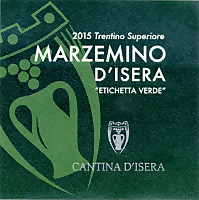
|
|
Trentino Superiore Marzemino d'Isera Etichetta Verde 2015 |
|
| Cantina d'Isera (Trentino, Italy) | |
 Marzemino Marzemino | |
| Price: € 11.00 | Score: |
 Intense ruby red and nuances of ruby red, little transparency. Intense ruby red and nuances of ruby red, little transparency. Intense, clean, pleasing and refined, starts with hints of black
cherry, plum and violet followed by aromas of blueberry, blackberry,
raspberry and almond. Intense, clean, pleasing and refined, starts with hints of black
cherry, plum and violet followed by aromas of blueberry, blackberry,
raspberry and almond.
 Properly tannic attack and however balanced by alcohol, good body,
intense flavors, agreeable. Properly tannic attack and however balanced by alcohol, good body,
intense flavors, agreeable.
 Persistent finish with flavors of black cherry, plum and blueberry. Persistent finish with flavors of black cherry, plum and blueberry. Aged in cement tanks. Aged in cement tanks. |
|
 Cold cuts, Pasta with meat and mushrooms, Sauteed meat, Roasted white meat Cold cuts, Pasta with meat and mushrooms, Sauteed meat, Roasted white meat |
|
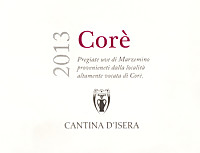
|
|
Trentino Superiore Marzemino d'Isera Corè 2013 |
|
| Cantina d'Isera (Trentino, Italy) | |
 Marzemino Marzemino | |
| Price: € 13.00 | Score: |
 Intense ruby red and nuances of ruby red, little transparency. Intense ruby red and nuances of ruby red, little transparency. Intense, clean, pleasing and refined, starts with hints of black
cherry, blueberry and violet followed by aromas of plum, blackberry,
cyclamen, raspberry, geranium and almond. Intense, clean, pleasing and refined, starts with hints of black
cherry, blueberry and violet followed by aromas of plum, blackberry,
cyclamen, raspberry, geranium and almond.
 Properly tannic attack and however balanced by alcohol, good body,
intense flavors, agreeable. Properly tannic attack and however balanced by alcohol, good body,
intense flavors, agreeable.
 Persistent finish with flavors of black cherry, blueberry and plum. Persistent finish with flavors of black cherry, blueberry and plum. Aged in cement and steel tanks. Aged in cement and steel tanks. |
|
 Cold cuts, Stuffed pasta with meat, Sauteed meat, Roasted white meat Cold cuts, Stuffed pasta with meat, Sauteed meat, Roasted white meat |
|
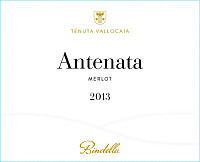
|
|
Antenata 2013 |
|
| Bindella (Tuscany, Italy) | |
 Merlot Merlot | |
| Price: € 38.00 | Score: |
 Intense ruby red and nuances of garnet red, little transparency. Intense ruby red and nuances of garnet red, little transparency. Intense, clean, pleasing, refined and elegant, starts with hints of
black cherry, black currant and plum followed by aromas of dried violet,
blueberry, chocolate, vanilla, tobacco, leather, mace, pink pepper and
eucalyptus. Intense, clean, pleasing, refined and elegant, starts with hints of
black cherry, black currant and plum followed by aromas of dried violet,
blueberry, chocolate, vanilla, tobacco, leather, mace, pink pepper and
eucalyptus.
 Tannic attack and however balanced by alcohol, full body, intense
flavors, pleasing roundness. Tannic attack and however balanced by alcohol, full body, intense
flavors, pleasing roundness.
 Persistent finish with flavors of black cherry, black currant and plum. Persistent finish with flavors of black cherry, black currant and plum. 16 months in cask, 12 months in bottle. 16 months in cask, 12 months in bottle. |
|
 Game, Roasted meat, Braised and stewed meat, Hard cheese Game, Roasted meat, Braised and stewed meat, Hard cheese |
|
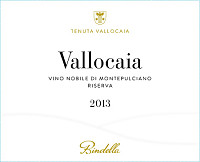
|
|
Vino Nobile di Montepulciano Riserva Vallocaia 2013 |
|
| Bindella (Tuscany, Italy) | |
 Sangiovese (90%), Colorino del Valdarno (10%) Sangiovese (90%), Colorino del Valdarno (10%) | |
| Price: € 30.00 | Score: |
 Brilliant ruby red and nuances of ruby red, little transparency. Brilliant ruby red and nuances of ruby red, little transparency. Intense, clean, pleasing, refined and elegant, starts with hints of
black cherry, plum and violet followed by aromas of blueberry, blackberry,
raspberry, rose, vanilla, tobacco, cocoa, cinnamon, mace and menthol. Intense, clean, pleasing, refined and elegant, starts with hints of
black cherry, plum and violet followed by aromas of blueberry, blackberry,
raspberry, rose, vanilla, tobacco, cocoa, cinnamon, mace and menthol.
 Tannic attack and however balanced by alcohol, full body, intense
flavors, agreeable. Tannic attack and however balanced by alcohol, full body, intense
flavors, agreeable.
 Persistent finish with flavors of black cherry, plum and raspberry. Persistent finish with flavors of black cherry, plum and raspberry. 2 years in cask, 1 year in bottle. 2 years in cask, 1 year in bottle. |
|
 Game, Roasted meat, Stewed and braised meat, Hard cheese Game, Roasted meat, Stewed and braised meat, Hard cheese |
|
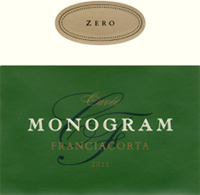
|
|
Franciacorta Dosage Zero Monogram 2011 |
|
| Castel Faglia (Lombardy, Italy) | |
 Chardonnay (80%), Pinot Nero (20%) Chardonnay (80%), Pinot Nero (20%) | |
| Price: € 18.80 | Score: |
 Brilliant golden yellow and nuances of straw yellow, very transparent,
fine and persistent perlage. Brilliant golden yellow and nuances of straw yellow, very transparent,
fine and persistent perlage.
 Intense, clean, pleasing, refined and elegant, starts with hints of
apple, bread crust and plum followed by aromas of ripe banana, citrus
fruits, hazelnut, grapefruit, hawthorn, yeast, butter, honey and mineral. Intense, clean, pleasing, refined and elegant, starts with hints of
apple, bread crust and plum followed by aromas of ripe banana, citrus
fruits, hazelnut, grapefruit, hawthorn, yeast, butter, honey and mineral.
 Crisp and effervescent attack, however balanced by alcohol, good body,
intense flavors, pleasing roundness. Crisp and effervescent attack, however balanced by alcohol, good body,
intense flavors, pleasing roundness.
 Persistent finish with flavors of apple, bread crust and plum. Persistent finish with flavors of apple, bread crust and plum. Refermented in bottle on its lees for at least 30 months. Refermented in bottle on its lees for at least 30 months. |
|
 Stuffed pasta, Roasted fish, Roasted white meat, Mushroom soups Stuffed pasta, Roasted fish, Roasted white meat, Mushroom soups |
|
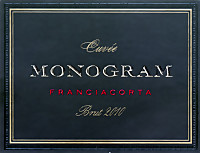
|
|
Franciacorta Brut Monogram Millesimato 2010 |
|
| Castel Faglia (Lombardy, Italy) | |
 Chardonnay (90%), Pinot Bianco (10%) Chardonnay (90%), Pinot Bianco (10%) | |
| Price: € 41.00 | Score: |
 Brilliant straw yellow and nuances of straw yellow, very transparent,
fine and persistent perlage. Brilliant straw yellow and nuances of straw yellow, very transparent,
fine and persistent perlage.
 Intense, clean, pleasing, refined and elegant, starts with hints of
apple, banana and bread crust followed by aromas of pear, grapefruit,
hazelnut, hawthorn, yeast, honey, butter, mineral and hints of vanilla. Intense, clean, pleasing, refined and elegant, starts with hints of
apple, banana and bread crust followed by aromas of pear, grapefruit,
hazelnut, hawthorn, yeast, honey, butter, mineral and hints of vanilla.
 Effervescent and crisp attack, however balanced by alcohol, good body,
intense flavors, pleasing roundness. Effervescent and crisp attack, however balanced by alcohol, good body,
intense flavors, pleasing roundness.
 Persistent finish with flavors of apple, plum and grapefruit. Persistent finish with flavors of apple, plum and grapefruit. The base wine ferments in steel tanks and barrique. Refermented in
bottle on its lees for at least 36 months. The base wine ferments in steel tanks and barrique. Refermented in
bottle on its lees for at least 36 months.
|
|
 Stuffed pasta, Roasted fish, Roasted white meat, Broiled crustaceans Stuffed pasta, Roasted fish, Roasted white meat, Broiled crustaceans |
|
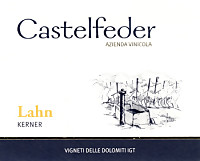
|
|
Lahn 2016 |
|
| Castelfeder (Alto Adige, Italy) | |
 Kerner Kerner | |
| Price: € 11.80 | Score: |
 Pale straw yellow and nuances of greenish yellow, very transparent. Pale straw yellow and nuances of greenish yellow, very transparent. Intense, clean, pleasing and refined, starts with hints of apple, pear
and lemon followed by aromas of peach, anise, hawthorn, broom, elder
flower, plum and nutmeg. Intense, clean, pleasing and refined, starts with hints of apple, pear
and lemon followed by aromas of peach, anise, hawthorn, broom, elder
flower, plum and nutmeg.
 Crisp attack and however balanced by alcohol, good body, intense
flavors, agreeable. Crisp attack and however balanced by alcohol, good body, intense
flavors, agreeable.
 Persistent finish with flavors of pear, peach and lemon. Persistent finish with flavors of pear, peach and lemon. 4 months in steel tanks. 4 months in steel tanks. |
|
 Pasta with fish and crustaceans, Fried fish, Broiled crustaceans, Dairy products Pasta with fish and crustaceans, Fried fish, Broiled crustaceans, Dairy products |
|
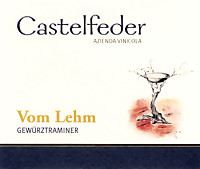
|
|
Alto Adige Gewürztraminer Vom Lehm 2015 |
|
| Castelfeder (Alto Adige, Italy) | |
 Gewürztraminer Gewürztraminer | |
| Price: € 12.80 | Score: |
 Intense golden yellow and nuances of golden yellow, very transparent. Intense golden yellow and nuances of golden yellow, very transparent. Intense, clean, pleasing and refined, starts with hints of grape, peach
and lychee followed by aromas of white rose, pear, apple, honey, pineapple,
nutmeg and sage. Intense, clean, pleasing and refined, starts with hints of grape, peach
and lychee followed by aromas of white rose, pear, apple, honey, pineapple,
nutmeg and sage.
 Crisp attack and however balanced by alcohol, good body, intense
flavors, pleasing roundness. Crisp attack and however balanced by alcohol, good body, intense
flavors, pleasing roundness.
 Persistent finish with flavors of grape, lychee and peach. Persistent finish with flavors of grape, lychee and peach. 4 months in steel tanks. 4 months in steel tanks. |
|
 Roasted fish, Roasted white meat, Stuffed pasta, Mushroom soups, Broiled crustaceans Roasted fish, Roasted white meat, Stuffed pasta, Mushroom soups, Broiled crustaceans |
|
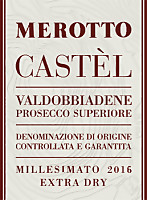
|
|
Valdobbiadene Prosecco Superiore Extra Dry Castèl 2016 |
|
| Merotto (Veneto, Italy) | |
 Glera Glera | |
| Price: € 17.00 | Score: |
 Brilliant greenish yellow and nuances of greenish yellow, fine and
persistent perlage, very transparent. Brilliant greenish yellow and nuances of greenish yellow, fine and
persistent perlage, very transparent.
 Intense, clean, pleasing and refined, starts with hints of pear,
wisteria and apple followed by aromas of peach, pineapple, tangerine,
broom, hawthorn and plum. Intense, clean, pleasing and refined, starts with hints of pear,
wisteria and apple followed by aromas of peach, pineapple, tangerine,
broom, hawthorn and plum.
 Effervescent and crisp attack, however balanced by alcohol, good body,
intense flavors, pleasing sweetness. Effervescent and crisp attack, however balanced by alcohol, good body,
intense flavors, pleasing sweetness.
 Persistent finish with flavors of pear, apple and peach. Persistent finish with flavors of pear, apple and peach. Fermented in closed tank for 50 days, aged on its lees for 4 months. Fermented in closed tank for 50 days, aged on its lees for 4 months. |
|
 Aperitifs, Vegetable and crustacean appetizers, Risotto with vegetables, Sauteed crustaceans Aperitifs, Vegetable and crustacean appetizers, Risotto with vegetables, Sauteed crustaceans |
|
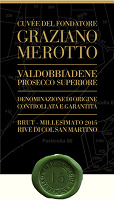
|
|
Valdobbiadene Prosecco Superiore Brut Rive di Col San Martino Cuvée del Fondatore Graziano Merotto 2016 |
|
| Merotto (Veneto, Italy) | |
 Glera Glera | |
| Price: € 18.00 | Score: |
 Brilliant greenish yellow and nuances of greenish yellow, very
transparent, fine and persistent perlage. Brilliant greenish yellow and nuances of greenish yellow, very
transparent, fine and persistent perlage.
 Intense, clean, pleasing, refined and elegant, starts with hints of
pear, peach and wisteria followed by aromas of apple, tangerine, pineapple,
broom, citrus fruits, hawthorn, kiwi, plum and mineral. Intense, clean, pleasing, refined and elegant, starts with hints of
pear, peach and wisteria followed by aromas of apple, tangerine, pineapple,
broom, citrus fruits, hawthorn, kiwi, plum and mineral.
 Effervescent and crisp attack, however balanced by alcohol, good body,
intense flavors, agreeable. Effervescent and crisp attack, however balanced by alcohol, good body,
intense flavors, agreeable.
 Persistent finish with flavors of pear, apple and peach. Persistent finish with flavors of pear, apple and peach. Fermented and aged in closed tanks for 6 months. Fermented and aged in closed tanks for 6 months. |
|
 Fish and crustacean appetizers, Sauteed crustaceans, Pasta and risotto with crustaceans Fish and crustacean appetizers, Sauteed crustaceans, Pasta and risotto with crustaceans |
|
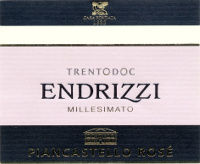
|
|
Trento Rosé Brut Pian Castello 2011 |
|
| Endrizzi (Trentino, Italy) | |
 Pinot Nero Pinot Nero | |
| Price: € 19.00 | Score: |
 Pale cherry pink and nuances of cherry pink, transparent, fine and
persistent perlage. Pale cherry pink and nuances of cherry pink, transparent, fine and
persistent perlage.
 Intense, clean, pleasing, refined and elegant, starts with hints of
cherry, raspberry and bread crust followed by aromas of strawberry,
cyclamen, apple, plum, citrus fruits, blueberry and hints of vanilla. Intense, clean, pleasing, refined and elegant, starts with hints of
cherry, raspberry and bread crust followed by aromas of strawberry,
cyclamen, apple, plum, citrus fruits, blueberry and hints of vanilla.
 Effervescent and crisp attack, however balanced by alcohol, good body,
intense flavors, pleasing roundness. Effervescent and crisp attack, however balanced by alcohol, good body,
intense flavors, pleasing roundness.
 Persistent finish with flavors of cherry, raspberry and strawberry. Persistent finish with flavors of cherry, raspberry and strawberry. Refermented in bottle on its lees for 60 months. Refermented in bottle on its lees for 60 months. |
|
 Stuffed pasta, Roasted white meat, Roasted fish, Mushroom soups Stuffed pasta, Roasted white meat, Roasted fish, Mushroom soups |
|
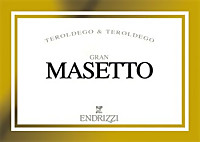
|
|
Gran Masetto 2012 |
|
| Endrizzi (Trentino, Italy) | |
 Teroldego Teroldego | |
| Price: € 39.00 | Score: |
 Deep ruby red and nuances of garnet red, impenetrable. Deep ruby red and nuances of garnet red, impenetrable. Intense, clean, pleasing, refined and elegant, starts with hints of
plum, blackberry and black cherry followed by aromas of dried violet,
blueberry, tobacco, vanilla, chocolate, leather, licorice, pink pepper,
mace and menthol. Intense, clean, pleasing, refined and elegant, starts with hints of
plum, blackberry and black cherry followed by aromas of dried violet,
blueberry, tobacco, vanilla, chocolate, leather, licorice, pink pepper,
mace and menthol.
 Tannic attack and however balanced by alcohol, full body, intense
flavors, pleasing roundness. Tannic attack and however balanced by alcohol, full body, intense
flavors, pleasing roundness.
 Very persistent finish with long flavors of black cherry, blackberry
and plum. Very persistent finish with long flavors of black cherry, blackberry
and plum.
 20 months in barrique, 6 months in bottle. 20 months in barrique, 6 months in bottle. |
|
 Game, Roasted meat, Stewed and braised meat, Hard cheese Game, Roasted meat, Stewed and braised meat, Hard cheese |
|
News |
|
In this section are published news and information about events concerning the world of wine and food. Whoever is interested in publishing this kind of information can send us a mail to our address.
|
AquavitaeReview of Grappa, Distillates and Brandy |
|
|
||||||||||||||
Wine Guide ParadeMarch 2017
|
| |||||||
Privacy Policy | |||||||


| Copyright © 2002-2024 Antonello Biancalana, DiWineTaste - All rights reserved |
| All rights reserved under international copyright conventions. No part of this publication and of this WEB site may be
reproduced or utilized in any form or by any means, electronic or mechanical, without permission in writing from DiWineTaste. |